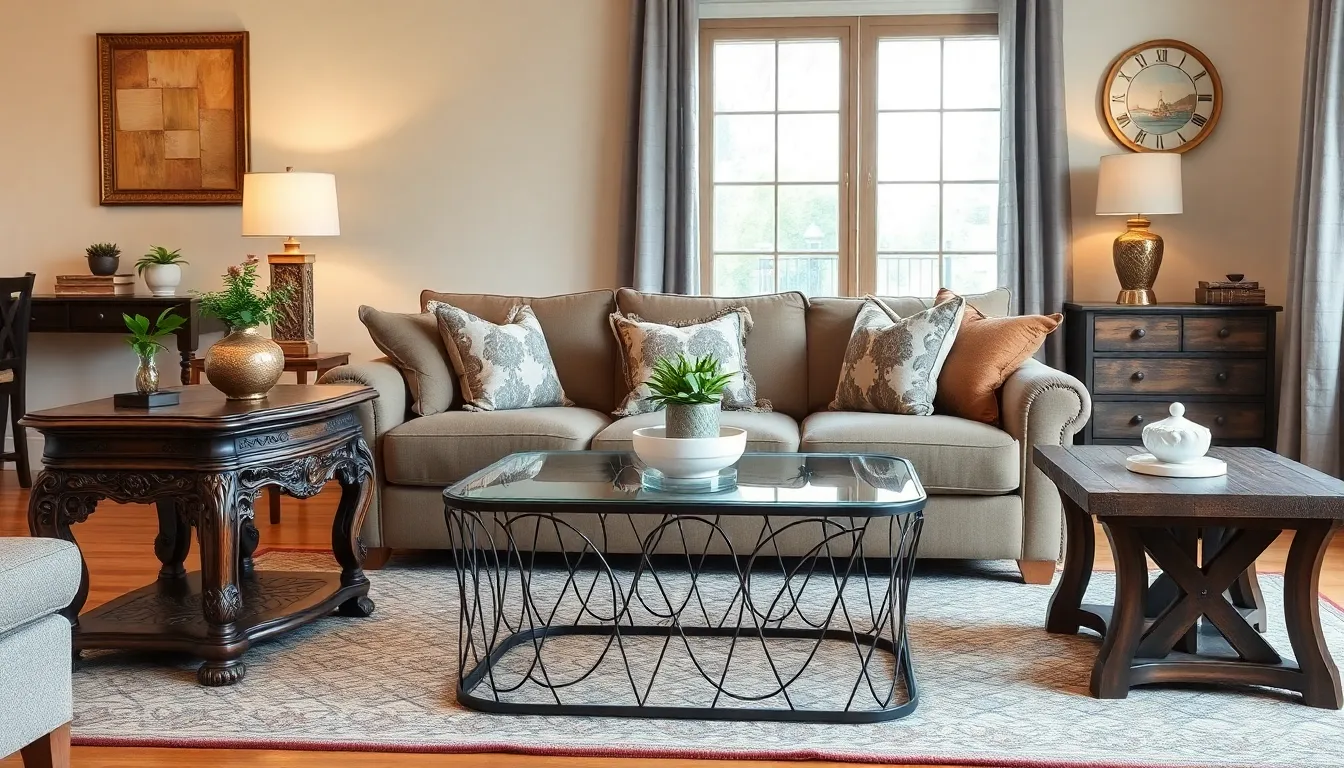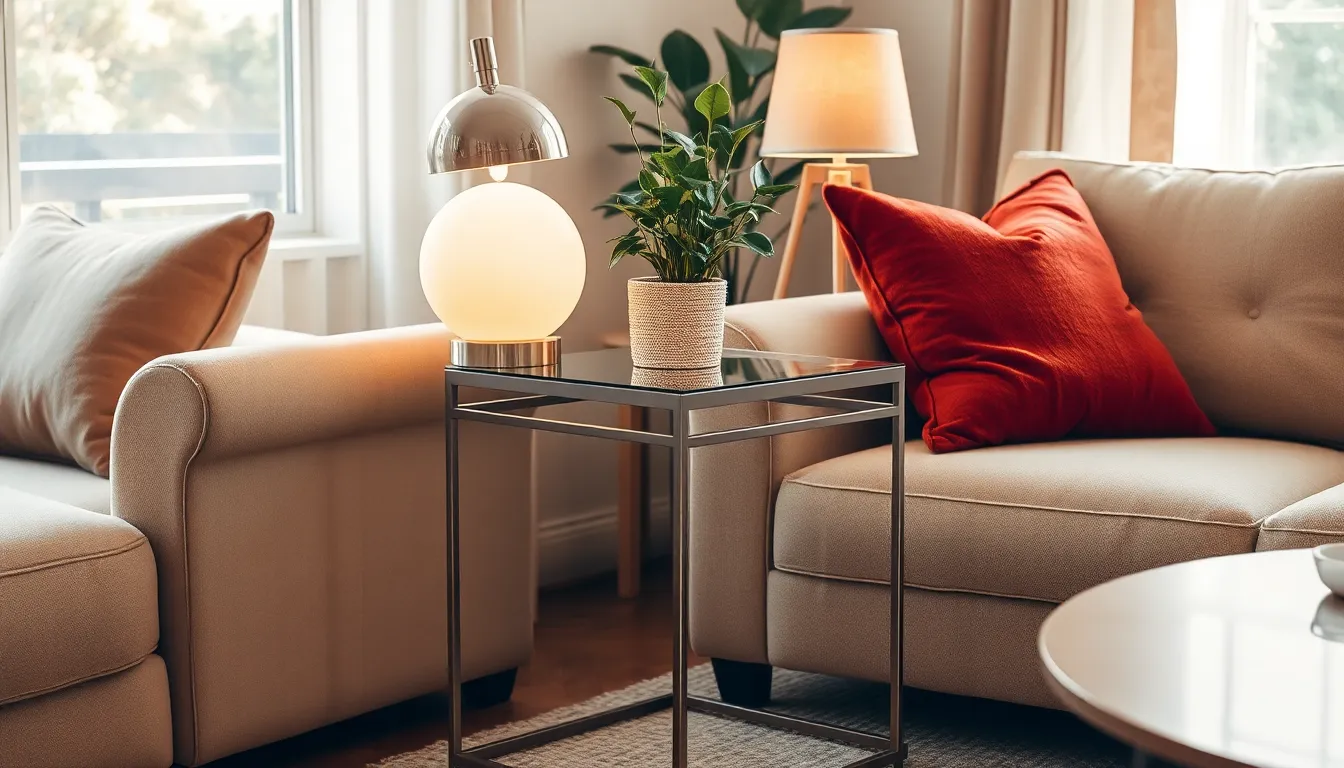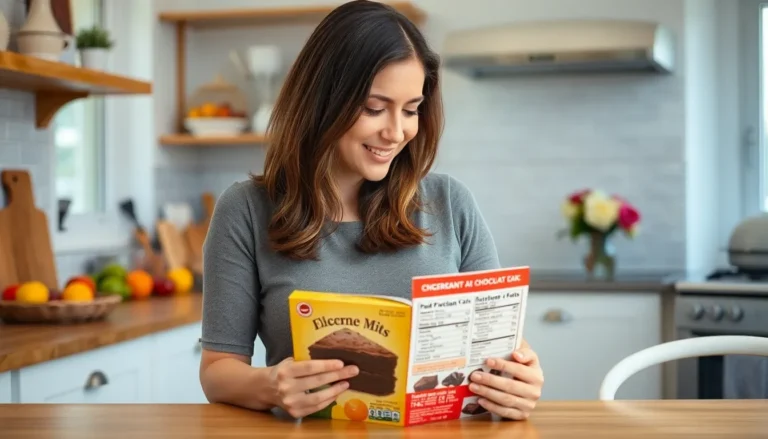Table of Contents
ToggleEnd tables might seem like the unsung heroes of home decor, but they’re more than just a place for that half-empty coffee cup or the latest best-seller. These versatile pieces can elevate a room’s style while adding functionality. Picture this: a cozy living room where every item has its purpose, and those end tables are the charming sidekicks making it all happen.
From holding snacks during movie night to showcasing your favorite plant, end tables bring both flair and practicality to any space. Plus, with countless designs, shapes, and materials available, there’s an end table that’s just waiting to match your unique style. So, let’s dive into the world of end tables and discover how these small but mighty pieces can transform any room into a stylish sanctuary.
Overview of End Tables
End tables serve significant roles in home decor. These pieces of furniture offer both functionality and style. Positioned next to sofas or chairs, they provide easy access to items like beverages or books. A wide array of designs and materials caters to diverse aesthetics and preferences.
Some end tables emphasize modern minimalist designs, featuring clean lines and neutral colors. Others embrace traditional styles with intricate details and rich wood finishes. The versatility of these tables allows them to fit seamlessly into various room layouts.
Beyond their decorative potential, end tables perform practical functions, including storage options. Many designs incorporate drawers or shelves, making them ideal for stashing remote controls or coasters. When chosen thoughtfully, they can complement other furnishings and elevate a living space’s overall look.
Different shapes, such as round, square, or oval, also contribute to their adaptability. A round end table might soften a room’s edges, while a square one adds structure. Furthermore, height variations cater to various seating arrangements, ensuring comfort and accessibility.
Consideration of material impacts the table’s durability and maintenance needs. Wooden end tables often offer a classic appeal, while metal or glass options can lend a modern touch. Selecting the right finish can enhance a room’s color scheme and ambiance.
Investment in a quality end table enriches the home environment, adding both style and utility. Their presence fosters a welcoming atmosphere, encouraging relaxation and social interaction. By integrating end tables into living spaces, one can significantly enhance functionality and aesthetic appeal.
Types of End Tables

End tables come in various styles, each offering unique characteristics that enhance home decor. Understanding these types can guide the selection process.
Traditional End Tables
Traditional end tables showcase craftsmanship and elegance. Often crafted from rich woods, these tables feature intricate carvings and detailed finishes. Drawers add functionality, allowing for discreet storage of items like coasters or remotes. Styles often include Queen Anne or Colonial, which blend seamlessly with classic decor. Their warm finishes invite a cozy feel, making them ideal for timeless interiors.
Modern End Tables
Modern end tables emphasize simplicity and clean lines. Materials range from sleek metals to glass, reflecting contemporary tastes. Minimalist designs focus on function, often incorporating open shelving for magazines or decor items. Neutral colors, like white or black, create a versatile look that complements various styles. These tables not only serve practical purposes but also enhance the aesthetic appeal of modern spaces.
Rustic End Tables
Rustic end tables bring warmth and charm to any room. Wood often features a distressed finish, highlighting natural grain and texture. These tables usually have a sturdy construction, ideal for a cozy lodge or farmhouse setting. Many designs incorporate unique elements, such as reclaimed wood or metal accents, adding a handcrafted feel. Their inviting nature encourages a relaxed atmosphere, perfect for gathering spaces.
Materials Used in End Tables
End tables come in a variety of materials, each offering unique attributes that enhance their functionality and style.
Wood
Wood remains a popular choice for end tables due to its classic appeal and durability. Many designs feature hardwoods like oak, maple, or walnut, which offer sturdiness and longevity. A rich wood finish can add warmth to a living space, complementing various decor styles. Some wooden end tables showcase intricate carvings or elegant details, emphasizing craftsmanship. The natural grains and textures present in wood create visual interest and a timeless feel. Wood’s ability to blend seamlessly with other materials enhances its versatility, making it suitable for both traditional and modern settings.
Metal
Metal end tables bring a contemporary touch, often featuring sleek lines and minimalistic designs. Common materials include stainless steel, aluminum, and wrought iron, all known for their strength and resistance to wear. Styles range from polished finishes to matte textures, allowing for personalization in design. Such tables frequently integrate open shelving or geometric shapes, enhancing aesthetics in modern interiors. The lightweight nature of metal makes it easy to move, accommodating various spaces effortlessly. Additionally, metal end tables often pair well with wooden pieces, creating an interesting contrast in materials.
Glass
Glass end tables exude elegance while offering a sense of openness in a room. Tempered glass is a popular choice for its strength and safety, making these tables durable. Many designs feature glass tops on metal or wooden bases, providing a sophisticated look without overwhelming a space. The transparency of glass allows for creative styling, showcasing decorative items underneath. Maintaining a clean, modern aesthetic is easy with glass, as it complements various colors and textures. Glass end tables can enhance both light and space, making them ideal for smaller living areas.
Styling Your Space with End Tables
End tables serve as important design elements that can elevate the overall aesthetics of a room. Their placement and surrounding decor contribute significantly to the ambiance of the space.
Placement Ideas
Positioning end tables near seating arrangements enhances accessibility to essentials like beverages and snacks. Consider placing a table next to a sofa or armchair to create a functional and inviting setup. An end table in the corner can maximize space while showcasing decorative items. Arranging multiple tables in a grouping can create a cohesive look and allow for varied heights and shapes, adding visual interest. Experimenting with different styles and sizes can further emphasize the personality of the room.
Complementary Decor
Incorporating artful pieces alongside end tables enhances their visual appeal. A stylish lamp or unique plant can create a focal point, drawing the eye to the end table. Arrange coasters, books, or decorative trays on the surface to add practicality and style. Utilizing color schemes that match or contrast with nearby furniture unifies the room’s decor. Textured items like woven baskets or ceramics can introduce depth, making the space more inviting. By thoughtfully combining decor, end tables become significant contributors to a room’s character.
End tables are more than just functional furniture; they’re essential components of home decor that enhance both style and usability. With their diverse designs and materials, they can seamlessly fit into any aesthetic while providing practical benefits. Whether opting for a modern metal piece or a rustic wooden table, the right end table can elevate a room’s ambiance and make it more inviting.
Thoughtful placement and creative arrangements can further maximize their impact, turning them into focal points that unify the decor. By choosing end tables that align with personal taste and functional needs, individuals can create a harmonious living space that encourages relaxation and social interaction. Investing in quality end tables is a simple yet effective way to enrich home environments and enhance overall comfort.








